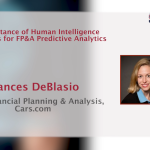In this article, the author explains why AI/ML is not magic, even though some might think...

Budgeting and forecasting are crucial components of Financial Planning for any organisation, as they enable companies to align their resources and goals. However, the traditional budgeting process can be lengthy, inefficient, and time-consuming. Recent years have seen an increasing interest in new ways of tackling the annual budget cycle, such as Zero-Based Budgeting, Rolling Forecasts, or Predictive Planning. Predictive Planning is a more dynamic and agile approach that focuses on predicting the outcome and taking proactive steps to ensure it is achieved rather than reacting to the outcome when it is too late to make meaningful changes.
Predictive Planning is proving particularly effective, thanks to advanced data analytics and Artificial Intelligence techniques. The use of Predictive Planning allows the finance team to leverage the power of data analytics and Artificial Intelligence to forecast future trends and patterns, identify potential risks and opportunities, and take proactive steps to optimise business results. This empowers FP&A teams to make data-driven decisions in real-time, leading to better financial outcomes for the business. The Predictive Planning process is highly automated, with data analytics tools doing most of the heavy lifting. As a result, FP&A teams can spend more time on value-added activities such as strategic financial analysis rather than time-consuming data collection and manipulation. Moreover, Predictive Planning is scalable, which means it can be applied to businesses of any size or complexity.
Accuracy and risk mitigation are key benefits of Predictive Planning, as advanced analytics techniques and sophisticated algorithms can identify and analyse large volumes of data at high speed, providing more precise forecasts. Automated data processing saves time, allowing teams to focus on higher-value tasks. Financial Planning and Analysis (FP&A) teams will also gain greater visibility into business performance and can quickly adjust to align with company goals.
In this article, we explore the benefits of Predictive Planning and Forecasting and how businesses can implement this approach successfully.
What is Predictive Planning and Forecasting?
Predictive Planning and Forecasting involve analysing historical data, identifying trends and patterns, and using sophisticated algorithms to forecast future outcomes. By doing so, businesses can take proactive steps to optimise their results and mitigate risks. This requires shifting from a linear, static budgeting approach to a more dynamic, agile one.
Predictive Planning can be used to forecast financial outcomes (budgeting), such as revenue, expenses, and profits. This information can help companies make informed decisions about investments, budgeting, and other financial matters. For example, you can model price assumption, market condition and historical sales trends to forecast the revenue.
Predictive Planning can greatly simplify budget exercise, eliminating bottom-up iterative processes and minimising target negotiation.
Predictive Planning can also be used to forecast resource needs, such as equipment, materials, and personnel. This can help companies optimise their operations and avoid shortages or overages. Or to identify potential risks and develop strategies to mitigate them. For example, a company can use predictive analytics to identify areas of their supply chain vulnerable to disruption and develop contingency plans to minimise the impact.
Benefits of Predictive Planning and Forecasting
There are several benefits to implementing Predictive Planning and Forecasting in your business:
- More Accurate Forecasts: Businesses can generate more accurate forecasts by leveraging data analytics and advanced algorithms than traditional budgeting methods. This is particularly true for companies with large volumes of data, where manual analysis can be slow and error-prone.
- Risk Mitigation: Predictive Planning can help businesses identify and proactively mitigate potential risks. This improves decision-making and leads to better financial outcomes for the business.
- Cost Savings: Automation and data analytics tools can help free up FP&A teams to focus on high-value activities, such as strategic financial analysis. This reduces the time spent on data collection and manipulation, resulting in cost savings for the organisation.
- Scalability: Predictive Planning can be applied to businesses of any size or complexity, making it a highly scalable solution. It is handy for companies with multiple subsidiaries or business units, as it allows for centralised finance planning efforts and provides greater visibility across the organisation.
Implementation Steps
Implementing Predictive Planning and Forecasting requires a comprehensive approach that involves several key steps. From my experience, below are a few things to pay attention to before embarking on a Predictive Planning journey.
1. Align with Top Management
Before embarking on any new budgeting approach, it is important to get buy-in and support from top management. This involves communicating the benefits of Predictive Planning and the potential impact on the business. FP&A teams should also work closely with other departments, such as sales, marketing, and operations, to ensure everyone is aligned on the forecasting approach.
2. Ensure Clean and Reliable Data
Clean, accurate, and consistent data is crucial for Predictive Planning to be effective. This requires a well-governed data lake that is properly maintained, with systems, processes, and roles in place to ensure data quality.
3. Build Trust in AI Forecasting
The success of AI-generated forecasts hinges on the trust they inspire within the organisation. To achieve this, leverage AI to predict quarter-end closing results and display the deviation alongside actual figures. This will demonstrate the reliability of these predictions and instil confidence in their accuracy. To further bolster trust, begin publishing AI-generated forecasts 12 months prior to their use in the budget cycle. This allows ample time to fine-tune the models and build confidence in their efficacy. Additionally, consider allowing teams to challenge the AI forecast through a bottom-up approach in the first year. Once they witness the sensible results, they will trust the model and become more receptive to the targets they receive.
4. Revisit Incentive Schemes
Predictive Planning may require businesses to revisit their incentive schemes for managers. With less control over financial targets, incentives may need to be based on such metrics as customer satisfaction, employee engagement, market shares, or other quality metrics. This requires a cultural shift and a willingness to let go of some traditional performance indicators.
Conclusion
The implementation of Predictive Planning and Forecasting can have a profound impact on both the finance function and the entire organisation. This transformation should not be underestimated, and the appointment of a Transformation Lead can facilitate a smooth transition. Considering the impact on teams and headcount is crucial, as some were dedicating up to 9 months per year to budgeting and forecasting. By establishing proper governance, utilising forecasting models, and securing buy-in from top management, FP&A teams can generate precise predictions and make real-time, data-driven decisions. This results in superior financial outcomes and a more adaptable, agile approach to budgeting.
While the implementation process may be complex and require a mindset shift, the benefits of Predictive Planning can far outweigh the costs. Businesses that embrace this approach to budgeting will be better equipped to navigate the complexities of the modern business environment and drive improved financial results.
Any views or opinions expressed are solely those of the author and do not necessarily represent those of any companies the author has been and is working for.
Subscribe to
FP&A Trends Digest

We will regularly update you on the latest trends and developments in FP&A. Take the opportunity to have articles written by finance thought leaders delivered directly to your inbox; watch compelling webinars; connect with like-minded professionals; and become a part of our global community.




